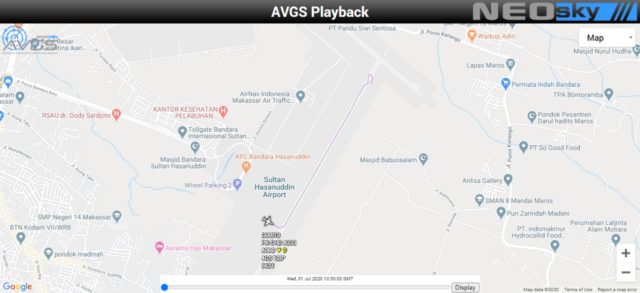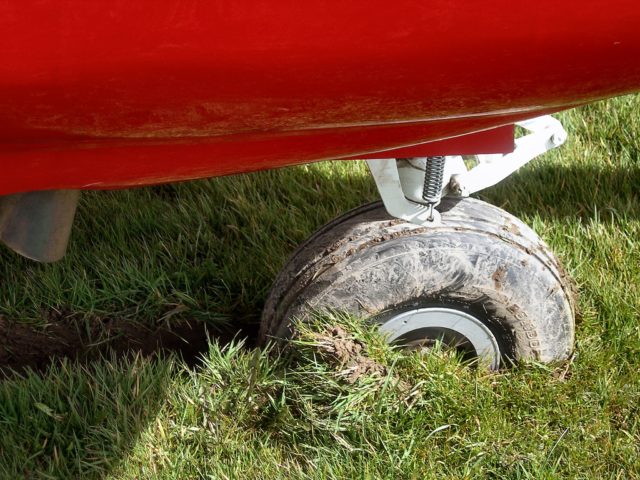Garuda Airbus A330 stuck in the mud
It was some time ago when I managed to get the Piper Saratoga so bogged down in the mud that my aircraft had to be towed out by four strong men and a landrover. I was attempting a short cut, in a rush to depart, and thought that I could save time by cutting across a bit of grass rather than remain on the taxiway. I was wrong.
When I saw the news on Wednesday, I’m going to admit that it made me feel a little bit better that I’m not the only pilot who this has happened to.

At the Sultan Hasanuddin International Airport in Makassar, a Garuda Indonesia Airbus A330-300 scheduled for a one hour domestic passenger flight to Jakarta sank into the mud after a runway excursion off the side of the runway.
The Airbus was backtracking along the runway and attempted an 180° turn in order to position itself to line up for departure with 26 passengers on board. During the turn, the aircraft skidded off the runway
Garuda Indonesia A330 veers off the runway while preparing to depart from Sultan Hasanuddin Airport in Indonesia. No injuries reported. https://t.co/CiLJpz3a55 pic.twitter.com/SSDepy3q59
— Breaking Aviation News & Videos (@breakingavnews) July 1, 2020
Aviation Herald reports that that the nose gear and the left main gear sunk into the mud with only the right main gear on the paved surface.
The Airbus Takeoff Safety Training Aid manual has a table for the Lineup Distance Charts for a 180° turnaround. For the A330-300, the minimum runway width required for a 180° turn while maintaining the minimum edge safety distance is 70 metres (230 feet).
Runway 03/21 at Makassar is 45 metres across; a standard width for an international airport but only half that of what the flight crew needed to make the turn safely. There are no “turnpads” on the runway although the connecting taxiway could be used to allow for a larger turning circle.
One commentor on AVHerald says that the A330 can turn without margin in a width of just 48 metres. The runway was still not wide enough and besides, on this occasion, it seems they really needed that margin.
The reason for the 180° can be seen in the NOTAMS for Makassar:
Q) WAAF/QMXLC/IV/M /A /000/999/0504S11933E
A) WAAA
B) 20/04/20 05:26 C) 20/07/20 09:00
E) TWY WP BTN TWY G AND TWY H, AND TWY H CLSD DUE TO WIP RMK : HEAVY EQUIPMENT PRESENT
That is to say, there is a notice to airmen (NOTAM) that from the 20th of April to the 20th of July 2020 (B), a number of the taxiways (TWY) at Makassar (Aerodrome WAAA) are closed for work in progress (WIP) using heavy equipment.
Indonesia has been investing in upgrades at regional airports for the past decade or two, including repairing defective pavement and widening taxiways. AVHerald reports that they were turning for a departure on 03 while Indoflyer.net reports that the aircraft was backtracking and then turning for a departure on 21. The closed taxiways in the list above include both the taxiway for the threshold for 21 (TWY WP) and for the threshold of 03 (TWY H); however it seems to me that Indoflyer is correct based on the AVGS playback.

Gerry Soejatman, an aviation safety “pro & geek” based in Jakarta comes to the same conclusion, theorising that the Airbus A330 started the 180° turn too early, although he doesn’t appear to have read the NOTAM before posting so I don’t know how reliable this is.
Analysis of #GarudaIndonesia #GIA613 #PKGHD in #UPGairport this evening. Aircraft made the 180 turn too early, not giving itself enough space to make turn. Why he did that or why not go around the taxiways and enter from the other runway, is probably going to be investigated. pic.twitter.com/mN1v5I1DaW
— Gerry Soejatman (@GerryS) July 1, 2020
Either way, the taxiways would allow for some extra turning space but, in line with our previous discussion, it is quite possible that those taxiways had collected grit and other debris through the construction and the general disuse of the airport as a part of quarantine measures, which could result in a lack of traction.
Simple Flying: Garuda Indonesia A330 Gets Stuck In The Mud At Makassar
PK-GHD has kept flying in recent months but on reduced schedules. Before yesterday’s flights, the aircraft flew up to Seoul from Jakarta on Saturday, June 27, returning to Jakarta on Monday, June 30. Then it sat idle for 48 hours.
Of course, a new NOTAM came into play immediately:
A1460/20 NOTAMN
Q) WAAF/QMRLC/IV/NBO/A/000/999/0504S11933E005
A) WAAA B) 2007011220 C) 2007011600
E) RWY 03/21 CLSD DUE TO BLOCK ACFT
Translation: Runway 03/21 closed as it is blocked by an aircraft. The flight was cancelled and as of yesterday, the aircraft was still at Makassar.
The Airbus A330 was towed out of the mud that night. I presume it required a bit more than a Landrover to get it out.









I’ve had enough of my own trouble when trying to taxi in/out of non-paved surfaces I quickly made a personal rule – no more of that! :)
Well Sylvia, nobody is perfect (not even I am, only nearly so!).
And yes, I confess it has happened to me!
I was cocky. I thought that I knew everything that the SN601 Corvette was capable of. And I was going to demonstrate to my co-pilot that I could swing the aircraft around with only a few inches to spare.
Well, either I did not make the swing tight enough or I misjudged.
Anyway, one main wheel went off the pavement of the east ramp at Shannon Airport. It did not sink in the muck, but the hard surface was just a bit higher than the grass.
At least I had the good sense to stop and get the mechanics to bring the plane back onto the hard stand. There was no damage other than a red face.
During the war with Biafra a Pan African Airlines DC6 got stuck in the mud at Enugu Airport (DNEN).
A bit sad, it was the first flight of the captain, Kurt Yeager, after his promotion. I mention his name because in all fairness, it could – and probably would – have happened to anyone else in the same position.
Enugu had been liberated (Ibo Nigerians might object to the word “liberated”) by the Federal Government. The DC6 was on a flight, if I remember correctly, with relief goods.
Enugu was full of transport aircraft and so there was an overflow parking that required moving over a grass area. The parking in front of the Pan African apron at Lagos also involved taxiing over grass, so Kurt was happy enough obeying the “Follow Me” vehicle.
Unfortunately the airport had suffered some light bomb damage. No more than a few small craters, but one of them, repaired and filled in, was in his path. Not really visible, but the sand was softer and caught his nosewheel. The crew tried to keep going by adding a lot of power. The nosewheel dug in deeper and collapsed.
A team from Fokker-Aviolanda came and spent weeks under a canopy (the rainy season had started) ,repairing the aircraft so that it could be flown with the nosegear down.
A fairing was constructed around the nosewheel to reduce drag. It was subsequently flown to the Fokker Woensdrecht base for permanent repair.
I think that this DC6 (5N-AFT) is visible in a photo of the Pan African ramp in one of my contributions.